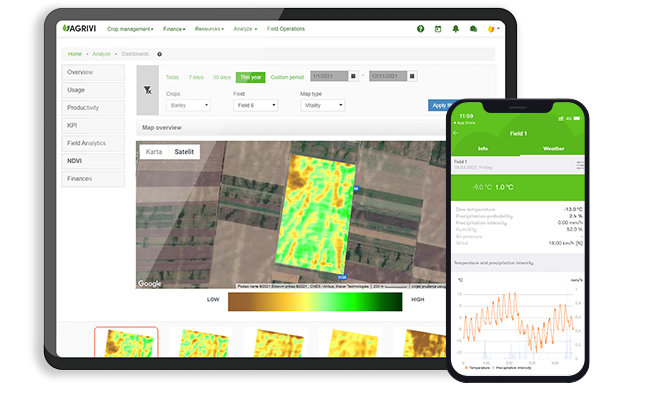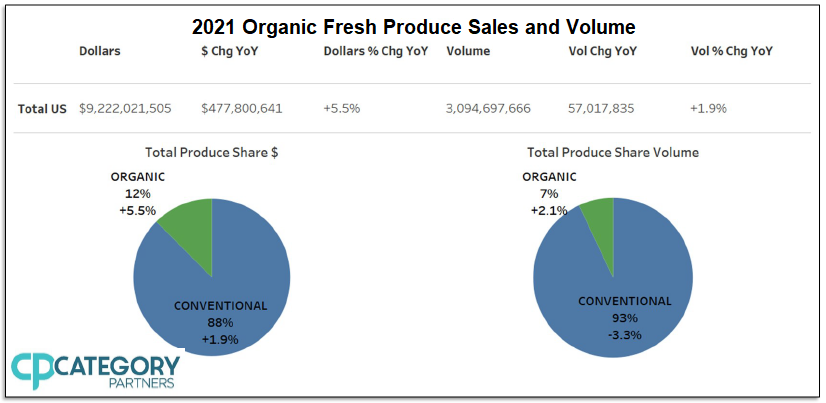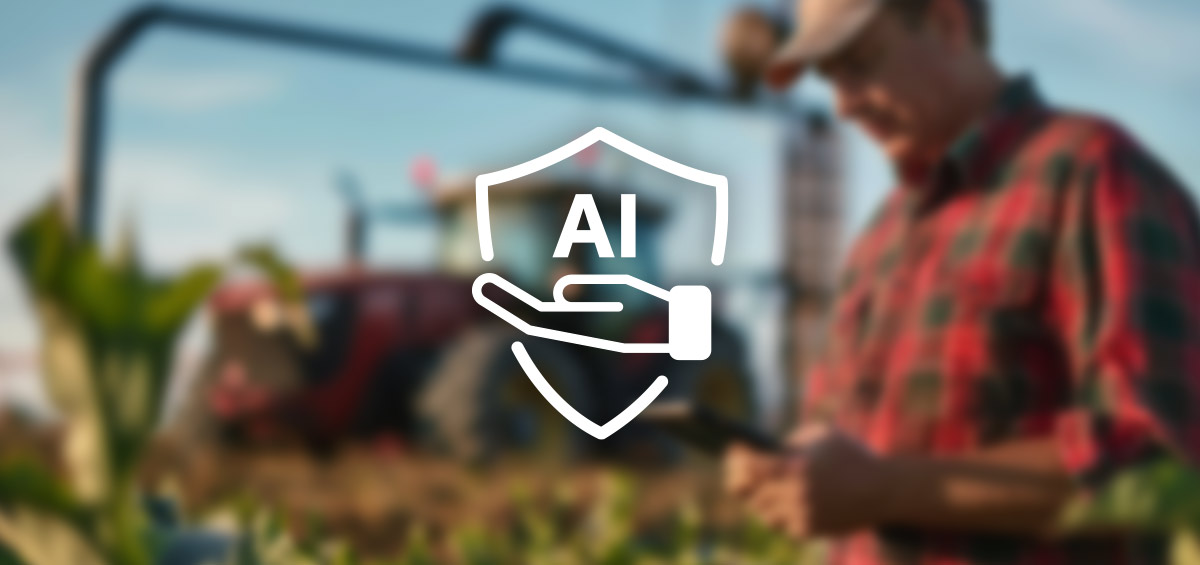By all accounts, organic agriculture is soaring in popularity. Consumers are increasingly shifting their food choice priorities to a focus on foods they perceive to be healthier for themselves and the environment.
U.S. organic sales reached record heights in 2020, reaching nearly $62 billion and for the first time, surpassing more than $60 billion in annual sales. In 2021 organic fresh produce sales grew by 5.5%, faster than conventionally-grown produce year-over-year sales, according to the 2021 Organic Produce Performance Report.
In Europe, organic agriculture has followed a similar trajectory. The European organic market increased by 15% in 2020, reaching a new record high of €52 billion. Even in developing regions, like India and parts of Africa, organic is gaining steam.
However, land in organic farming methods is still a small percentage of the world’s farmland. In 2017 organic land area across all continents jumped 20% over 2016. However, even with that increase, organic farmland still represented just 1.4% of total worldwide agricultural lands.
But is organic farming on track to eclipse and overtake conventional farming? Or, will organically-produced crops remain as a relatively small percentage of the overall global food supply?
And, what do farmers need to consider if they pondering switching their farm management practices from conventional or organic farming? Or vice versa?
Table of Contents
Organic vs. Conventional Farming
Which is better? Organic versus conventional farming? The answer is, it depends. Farmers have many factors to consider when making management decisions. But there are some clear differences between organic farming methods and non-organic farming practices.
What is Organic Farming?
Organic farming is a type of food production that eschews man-made, chemical fertilizers, herbicides and pesticides in favor of natural products and methods.
The organic movement focuses on underlying principles of biodiversity and soil health, climate and environment protection, animal welfare and the absence of genetically modified organisms (GMO) or gene-edited crops.
In most developed nations, the organic sector has its own certification process and farmers must follow strict rules and yearly certification to claim their products as organic. In the U.S., organic certification is managed by the United States Department of Agriculture (USDA). In the European Union, organic certification is administered by approved certification agencies.
What is Conventional Farming?
There is no certification process for conventional farming like there is for organic farming. Instead, conventional farming is generally considered to be farming methods that include some element of man-made inputs, like synthetic nitrogen fertilizers or chemically-produced herbicides or pesticides like glyphosate (an herbicide). Conventional farmers may also use GMO or gene-edited seeds or products in their production.
However, most farmers that use conventional methods still focus heavily on soil health and improving upon their natural resources.
For instance, one of the biggest environmental successes of commodity-crop production in the U.S. has been the adoption of no-till farming practices, a type of production that eschews tillage and focuses on soil fertility. No-till farmers plant their cash crops into previously planted cover crops. However, because they aren’t using tillage, weed control becomes an issue forcing many no-till farmers to depend upon chemical herbicides.
Soil erosion rates on U.S. croplands have decreased 35% between 1982 and 2017, according to the USDA, in large part because of the adoption of no-till, planting cover crops, crop rotation, strip tillage and other conservation farming practices that support soil health and reduce emissions.
Organic Versus Conventional Farming – a Tale of Two Farmers
What type of farming methods a farmer chooses will depend heavily upon many things, including their natural environment, economic opportunities and their past successes and failures in farming.
Conventional Farmer Switches to Organic Farming
Arvind Pande farms more than 70 acres in the Madhya Pradesh state in India. He farmed using conventional methods for many years but decided to stop using chemicals and switch to organic farming because his soil had been losing fertility over time, forcing him to use more and more chemicals.
Pande was also forced to buy large, expensive equipment. Between his equipment and chemical costs and poor yields, Pande began questioning the future of farming. He switched to organic farming and his soil quickly began to recover. He now uses manure from his dairy cows for fertilizer and recycles it extensively. Pande’s biggest challenge is finding how to get his products more directly to food markets so he can capture more profit rather than selling his crops through middlemen in the supply chain.
Conventional Farmer Uses No-Till to Improve Soil Health
Maine farmers Bob and Travis Fogler are conventional farmers, using chemicals for their weed management. However, no-till and cover cropping practices have greatly improved their soil health and saved them money and time.
The Fogler’s raise about 1000 head of dairy cows and 1350 acres of corn, alfalfa and grasses they feed to the cows plus additional cash crops like potatoes. They switched to no-till in 2008 by accident, after planting no-till corn into a winter-killed sod. They were using the corn to simply break up the sod, thinking it wouldn’t produce a harvestable crop, however, were pleasantly surprised when the corn grew outstandingly well.
Encouraged, they began following sustainable agriculture practices, using more cover cropping and no-till methods, especially on their poorest quality soils suffering from degraded soil health as the result of decades of intensive tillage-based production. Since switching, their soil has become more resilient to drought and heat and soil erosion has been reduced. They also have saved money on tillage equipment, fuel and time and have also been able to decrease their need for chemical weed control over time.
Which is a More Profitable Farming System? Conventional or Organic?
Pursuing organic status can open up marketing opportunities for farmers and increase how much they are paid for their crops.
A 2014 research study found that organic farmers were between 22 and 35% more profitable than conventional farmers due to high market demand and higher premiums paid as compared to conventional crops. However, yields are generally lower for organic crops (although not always), that same 2014 study noted that yields in organic production were sometimes up to 18% lower than conventionally-grown crops.
Organic producers may incur more pest and disease damage on their crops than conventional growers, creating more food waste. And, of course, there is no guarantee a high premium paid for an organic crop will remain that high. Organic growers sell within the competitive marketplace just like conventional farmers, and sometimes their products are in high demand but other times there may be a surplus.
On the other hand, organic farmers generally report that they save money on expensive fertilizers and chemicals. Bottomline, which system is more profitable really depends on a farmer’s market potential, the crops they grow and the challenges of their particular natural resources.
Farming in the Future
What will the future of agriculture look like? Will it incorporate more organic agriculture? Or conventional agriculture?
Farming practices are rapidly evolving in response to climate change, supply chain upheavals and a growing demand from consumers for healthy food grown sustainably. But we are also experiencing an exploding global population, especially in traditionally impoverished regions of the world.
Global food security is dependent upon enough food, grown using practices that don’t sacrifice ecosystems or worsen climate change. So, what does that mean for the two main agricultural philosophies farmers use – organic versus conventional farming?
The Future of Organic Farming
Based on the recent rapid market growth of organic food products plus predicted wealth expansion in developing nations, it is a strong bet that organic producers will continue to be in high demand in the future.
However, the organic movement still faces challenges, including higher production costs and methods more destructive to soil health when tillage is used instead of chemicals for weed control. New, organic-approved products and evolving technology applicable to organic producers will help to increase organic farmers’ production efficiencies and keep them competitive in the marketplace.
Ultimately, consumers will drive the future demand for organic food products and currently, there is plenty of room in the organic sector for growth.
The Future of Conventional Farming
The future of conventional farming appears to be that it will evolve to look more similar to organic farming than it has in decades past. Even with the use of chemical products, conventional farmers are under market pressure to adopt more sustainable farming methods.
Production practices like no-till, or regenerative agriculture (a farming philosophy focused on soil health) are based on many of the same underlying principles the organic movement was founded on, like soil health, biodiversity and ecosystem management.
Conventional farmers will also see expanded use of technology and science, focused on resource efficiency and precision agricultural practices to help improve the environmental and economical sustainability of their farming practices. Even with the clamoring demand for organic products, conventional farming will remain a viable farming practice in the future.
Farm Management Software For All Farming Systems
Choosing to be an organic or conventional farmer is a highly subjective decision based on multiple factors. But either type of farming still needs an effective solution for farm data and task management.
AGRIVI’s farm management software platform covers all aspects of running a farm, no matter what type of practices you use. That includes setting pest alarms, and weather alerts, managing your irrigation system, and keeping track of fertilization and work orders for the farm crew.
Find out more:






